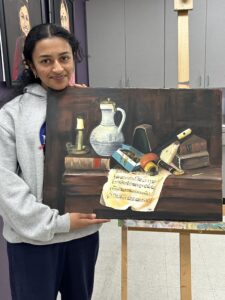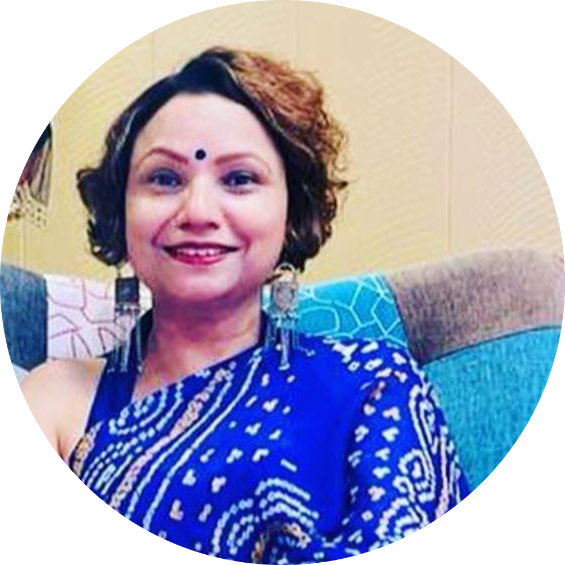Fashion-Transcending a Fabric Between Generations
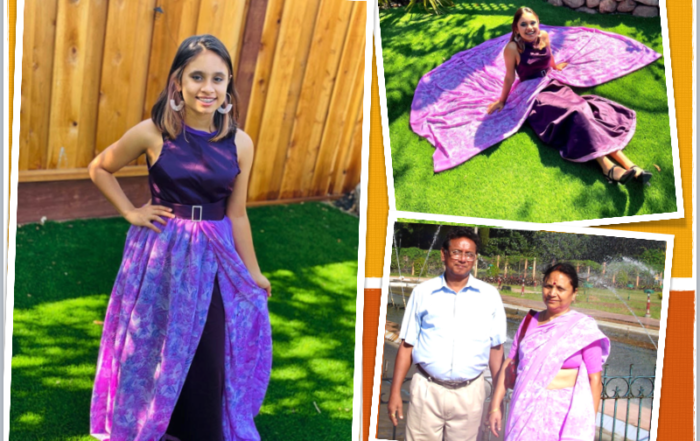
By- Saesha Sharda, Sophomore, 2021 My grandmother, Nani, had a beautiful saari: a purple one with floral patterns all over. Nani was amazing at dress-making and knitting. As far as I can remember, I have been wearing her hand-knitted sweaters and hand-me-downs. So, I decided to transform her purple saree into a formal designer dress/piece. With my mother’s help, I picked a deep wine-purple satin fabric to go with it and designed a simple ‘A‘-line under-dress with a raglan sleeve cut. With the saree fabric, I gathered it and created a wrap-around belt/skirt with gemmed buckle. This way, the under-dress + wrap-around skirt had the versatility to be tied anywhere, from the waist to even the shoulders. After countless sewing machine runs, weeks of time, mistakes, and redo the dress was complete. Wearing it, it feels as if I am embodying a purple butterfly. It was eye-opening to transform the fabric from one style to another and essentially pass it from one generation to another. The fabric had a distinct smell, a smell that reminded me of my Nani and my grandparent’s home in Dehradun. I remember her warm smile, gentle laugh, and beautiful aura by simply smelling that fabric. It is just a reminder that the saari, though it is nonliving, lived through my grandmother’s life and now it will live through mine; and this applies to any item of clothing. By using that purple flower-patterned fabric, I feel as if I am honoring her by honing her dressmaking skills and continuing her legacy.
Why do I Matter, coz I believe

By- Aditi Manchanda, Grade 8 This is my artwork from the Virtual Reflections Art Competition that was held during the month of October. The theme for this contest was “Why do I Matter”. The first thing that I did was make the head into a light bulb. This is the main portion of the focus of the topic “Why do I Matter”. I matter because I want to grow up and share my ideas with the world to make it a better place. This part of my art represents my ideas. One idea that I would like to spread awareness about equality. There are so many people in this world who get discriminated against because of the color of their skin, or their religion, or even because of their gender. They don’t get many opportunities that others do just because of their appearance or what they believe in. Because of all of this commotion, there are so many innocent people who get harmed. There is so much violence, protesting, and war especially with all the riots and chaos in 2020. This is why inside of the light bulb I wrote the word peace and made some scenery around it. I chose to make this piece because I love to draw fashion figures and wanted to incorporate that into my artwork. I made this figure sitting down with a red top and blue jeans. This part of my art represents me. I used colored pencils and a black pen (to trace) to complete my artwork. If used by themselves, colored pencils are used in two techniques – layering and burnishing. Layering is a technique usually used at the beginning of the drawing. Its idea is to use primary colors in layers and with that to get different tones. Burnishing is done on layers and for that is used a colorless blender or a light-colored pencil. For my artwork I used layering. I used this technique for the background in my light bulb. I just used one layer of color for the skin, clothes, and the mountains of my picture. Finally, I used brown paint to make the ledge that my figure is sitting on. The paint I used was acrylic. I hope that this was informative and encouraged you to support causes to make the world a better place. Thank you! — Aditi Manchanda Grade 8
Mumma Bear;Shading Techniques
By Saira Siraj, 7th Grade The first artwork (of the two that I will be talking about) that we did is a shading techniques page. Here we have 4 different ways to shade in a drawing, shading, scumbling, stippling, and hatching. I first made a 16by16 grid towards the bottom of the page. Then we drew two long rectangles, on the top of the page. In the first one, we made lines inside, making equal parts. Then we shaded the rectangle from lightest to darkest. Then below that, we made the same scale but as a gradient, this time with no partitions. In the 16by16 grid on the bottom half of the page, we made columns of different shapes, spheres, cubes, cylinders, and cones. We shaded each row with a different technique. Hatching, Scumbling, Stippling, and Shading. Scumbling was the easiest as it was like scribbling and Stippling took the longest because you have to be very careful with the dots and make sure they don’t look like lines. Hatching, Scumbling, and even Cross Hatching, all are similar because, to make the value darker, you need to make the lines/scribbles closer together to show the tightness. Our next artwork was a drawing of a mama bear and a baby bear. We were allowed to use any techniques that we wished, so I decided to do shading, as it would not take up as much time and I could still get a good-looking drawing. I started off by sketching the two bears. Then, we shaded the cave and the crevices of the bears really dark.
Village Scene, Warli Art
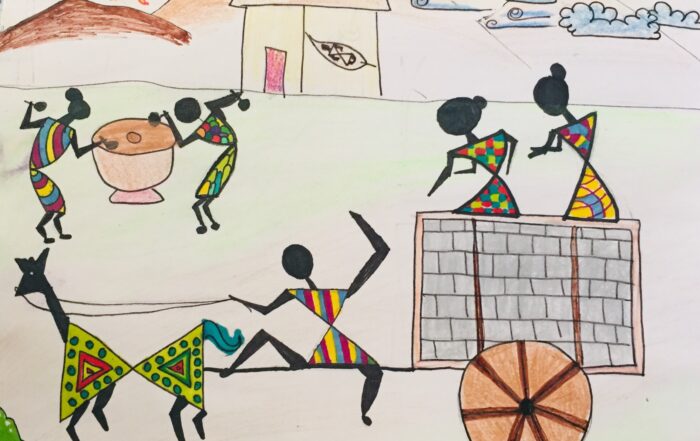
By, Minali Kancharla, Grade 7th The word Warli means a piece of land in the Varli language. Warli is a folk painting style native to India that mostly represents traditional everyday living and special events. The Warli style uses geometrical designs to make the main body of the subjects, this is for humans and animals. Warli painting uses basic shapes such as circles, triangles, and squares. The first step to this art is to sketch out your village scene using a set of basic shapes and make geometric patterns on the dresses. The page was then washed with tonal watercolor, to give a vintage effect. After the water wash on the page dries up, I outlined the sketch with a black point pen. The color scheme chosen for this artwork was Split complimentary, for this I chose two sets of split complementary colors. For each animal or human, use one set of complementary colors to fill the designs inside the subject. The end result is a colorful piece of art made from basic geometric shapes and colors.
Periodt…! periods are not our weaknesses, but our strengths
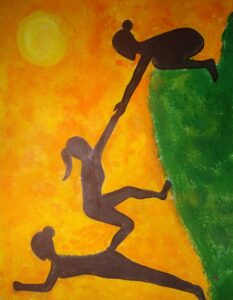
By -Saesha Sharda, Grade 9th When I was a little girl, I was not really encouraged to talk about menstruation, especially in front of my older family members and relatives. Not only was I confused about why periods occur, but also why I wasn’t allowed to talk about it. Now that I’m older and know about periods, I can comfortably talk about them with my parents whenever I have questions or concerns. Menstruation is a fascinating process that happens to almost every single woman on the planet, and I don’t understand why women get shunned for talking about it. Periods are not ‘gross’ or ‘weird’, they’re pretty cool. We need to empower women and encourage them to stand up and talk about light-hearted things like periods, to other heavier topics. My artwork on women empowerment ties into the concept of women helping women. In my artwork, I have shown three women helping each other climb a cliff through a fire. The cliff represents the normal hardships women have to go through, and the fire represents how the outside world makes it harder for women to achieve these tasks. I have used acrylic paint to show a silhouette of the women the background is with acrylic textures. It is important we address things like this through artforms for expressions, I feel it is a step in the right direction. Women are awesome! But, I do understand that the older generation was raised to not talk about women’s’ issues and menstruation, but it is time that changes. Our periods are not our weaknesses, but our strengths; and it’s pretty cool that we get to go through this cycle that perpetuates the entire human species!
Art for improving Hand Dexterity for Children

“The hands are the instruments of man’s intelligence”, – Maria Montessori. children’s dexterity is so important in their education and for their overall development. art has great role to play in this regard. Arts helps in refining hand dexterity help children develop their cognitive, social and motor abilities. Art plays major role in developing following areas: Cognitive abilities: Art teaches students that mistakes are alright and not end of the problems but can be redone. Art induces the mind to discover. It teaches young minds that any problem may have more than one solution. Art gives learning and the power to make their ideas come true through materials Social abilities: Teach them that they have to endure efforts. It nurtures the social skill that they should value the efforts of others. Art study works as therapies for children with difficulties. Creative processes are a way to create an integration in groups with various cultures. Motor skills: Fine motor skills are those that involve a refined use of the small muscles which control the hand, fingers, and thumb. Handling a pencil or brush correctly, using glue to stick, paper, feathers, glitter, and the like on a mask and drawing improve the children’s dexterity and their use of objects in a controlled way. It is an excellent way to develop eye-hand coordination. Any activities that include crafts or playing with loose parts will help kids develop hand dexterity. Every art lesson in Kalaa is created keeping the development of the child’s social, cognitive, emotional, and physical development in mind. The skills developed during the process of creating art will enable your child to meet with future success in school and life.
Pleasanton Landscape, My City My home
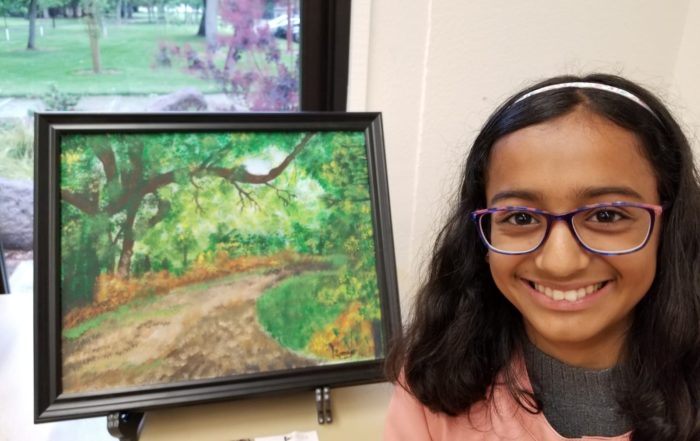
By Apoorva Kulshreshtha Pleasanton has many beauties. It has joyful downtown, the hiking trail called the Ridge, and a wonderful history. I painted a scene from the Ridge. It has trees and a trail. In my painting, there is a dusty pathway in the middle, trees in the distance and the front, some grass, and bushes of a variety of color. My painting included a bit of stipiling for the tree leaves, bushes, and the trail. My painting took a short amount of time. It was also my first painting I made in Kaala Art and Design. It was for the 2019 Kalaa Art and Design Exhibition. I like this painting because it has many different techniques in it and it has nature in Pleasanton. This painting is inspired by the artist, Vincent van Gogh. He was famous for post impressionists and the painting “The Starry Night”. Van Gogh died in 1890. I really like his artworks since the colors express how he is feeling in the painting and he makes landscape and people in his own style.
Traditional Art- Warli Painting
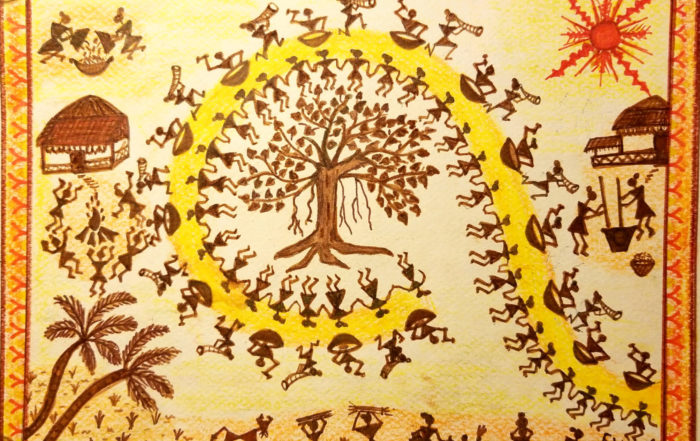
By Simi Tresa Originated by the Warli tribes from the Western Ghat of India, in 2500 BC, this one of the oldest art forms of India. The idea of warli centred around the concept of Mother Nature and parts of nature. Farming was the main source of life for this tribe. This art uses set of basic geometric shapes like circle, triangle, lines and square. These shapes were different elements of nature. Circles represented sun and moon while triangle represented mountains and pointed trees. In ritual paintings festivals and dances were common. People and animals represented by two inverse triangles joined at there tip. Warli also represent day to day life and activities of village people. One of the aspects that warli art depicts is the ‘Tarpa dance. Tarpa is a trumpet-like instruments played by village mens in turns. Men and women entwine there and hands and move in circle around the Tarpa player. Formation of circle by men and women in village said resemblance of circle of life.
Storytelling by Art Inspired by Madhubani Folk Art of India
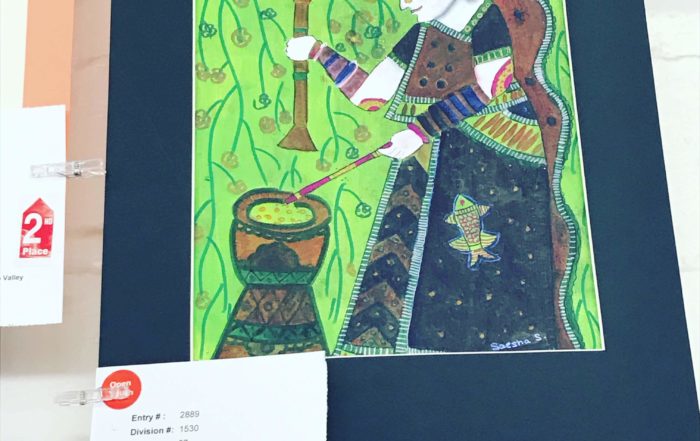
The beautiful thing about art is that it is universal. It has no language, no accent, and each piece of artwork tells a different story. Madhubani folk art is no exception as it is presented in a multitude of colors, mediums and most importantly, stories. Madhubani folk art originated in Bihar, India and is done by using fingers, twigs and matchsticks. They are known for figures that have large fish like eyes and pointed noses. There is never a blank space on the canvas and backgrounds are filled with colorful patterns. Furthermore, many geometric patterns in Madhubani art pieces represent love and bravery as well as prosperity. Madhubani pieces often depicts scenes from epics and also show different foods and animals. My Madhubani artwork is a recreation of a piece called “Village Woman” . In the artwork, a woman preparing food in a bowl like vessel. She is wearing a blue and red saari. The skirt of the saari has a drawing of a yellow fish on it. In addition, the woman is holding a two different sticks to prepare her meal. She wears jewelry such as earrings and bangles. The background of the piece is filled with green leaves and red flowers. The artwork is very colorful and lively and contains many patterns. I personally chose to recreate this artwork because I loved the bright color scheme and the designs were hard to miss. It was really fun to make the artwork. It was sort of therapeutic in a way because I was enjoying the drawing process and all of my stresses were cleared away. Madhubani folk art is a wonderful type of art. There are many artists creating beautiful Madhubani art pieces all around the world. Artworks capture scenes from different stories and contains so much meaning. The 2500 year old folk art still remains strong and will be respected for many, many years.Author: Saesha Sharda
Art has the role in education of helping children become like themselves
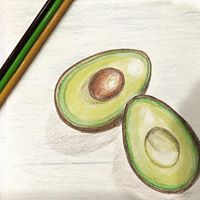
10 of the many skills children learn from art: 1. Creativity 2.Confidence 3.Problem-solving 4.Perseverance 5. Focus 6. Non-verbal communication 7. Receiving constructive feedback 8. Collaboration 9. Dedication 10. Accountability Arts education is a big part of building a 21st century creative mind, and I think that we have let way too many kids lose their way by not drawing in their young minds with music, dance, painting and the other various ways we can express those things we do not have words for. By Heather Watts Every time you engage in a new or complex activity, your brain creates new connections between brain cells. Your brain’s ability to grow connections and change throughout your lifetime is called brain plasticity or neuro-plasticity. Creating art stimulates communication between various parts of the brain. Art has the role in education of helping children become like themselves instead of more like everyone else. Decades of research have provided more than a sufficient amount of data to prove that arts education impacts everything from overall academic achievement to social and emotional development and so much more. Research has proven the arts develop neural systems that produce a broad spectrum of benefits ranging from fine motor skills to creativity and improved emotional balance Kala Art & Design studio, mission is in developing unique artistic voice, unlocking freedom of self-expression, and a light hearted but deeply meaningful approach of learning art and design. #kalaartanddesign, #art, #Design, #creativeminds, #littlehands #tinyfingerscreatingmagic




